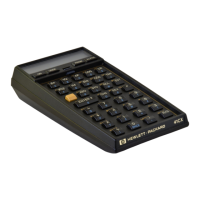
Do you have a question about the HP HP-41CX and is the answer not in the manual?
| Model | HP-41CX |
|---|---|
| Release Year | 1983 |
| CPU | Saturn |
| ROM | up to 64 KB |
| Manufacturer | Hewlett-Packard |
| Display Type | LCD |
| Display Digits | 12 |
| Special Features | extended functions |
| Category | Scientific / Programmable |
Details primary, alternate, and shift key functions for the Normal Keyboard.
Explains CLX/A, Back Arrow, and XEQ Execute functions on the Normal Keyboard.
Activates and deactivates the User keyboard for custom key assignments.
Procedure to assign functions to keys and execute them, including local label searching.
Covers primary, alternate, shift, and append functions for Alpha input.
Details storing, recalling, and clearing the Alpha register content.
Explains Back Arrow function and viewing the Alpha register during operation.
Functions to clear, set repeat intervals, and manage alarm dates and times.
Steps to step through, stop, restart, and exit the Alarm Catalog listing.
Details split, delta split mode, and clearing the stopwatch timer to zero.
Managing register addresses and display settings for stopwatch data.
Exiting the stopwatch function and controlling its run/stop state.
Cursor movement and record navigation within the text editing interface.
Inserting, deleting characters, records, and switching editing modes.
Exiting the editor and toggling keyboard input between Alpha and Numeric modes.
Using direct key presses or Alpha execution for accessing calculator functions.
Assigning functions to User keys and handling function parameter inputs.
Alphabetical list of functions with definitions and references to the owner's manual.
Explanation of display annunciators, low-power, keyboard active, and mode indicators.
Flags affecting digit separator, radix mark, shift set, and general flag status.
Indicators for program mode, program running status, and user input cues.
Describes data storage registers and uncommitted registers within main memory.
Details the number of registers available for text, data, or program files in extended memory.
Step-by-step instructions for storing a program in the calculator's main memory.
Executing stored programs, understanding indicators, and using R/S for control.
Conventions for interpreting clock time values, including 24-hour format results.
Describes Message, Control, and Conditional alarms and their operational behaviors.
Step-by-step guide to setting an alarm using the XYZALM function.
Procedures to halt flashing, repeating, or inactive alarms, and acknowledge non-message alarms.
Overview of the six catalog types: User Programs, External Functions, Standard Functions, etc.
How to use catalogs, including stopping, stepping, restarting, and speeding up listings.
Table showing ASCII codes, their display representation, and character mapping.
Details User, Control, and System flags, their numbers, names, and status.
Descriptions of common error messages, their meanings, and causes.